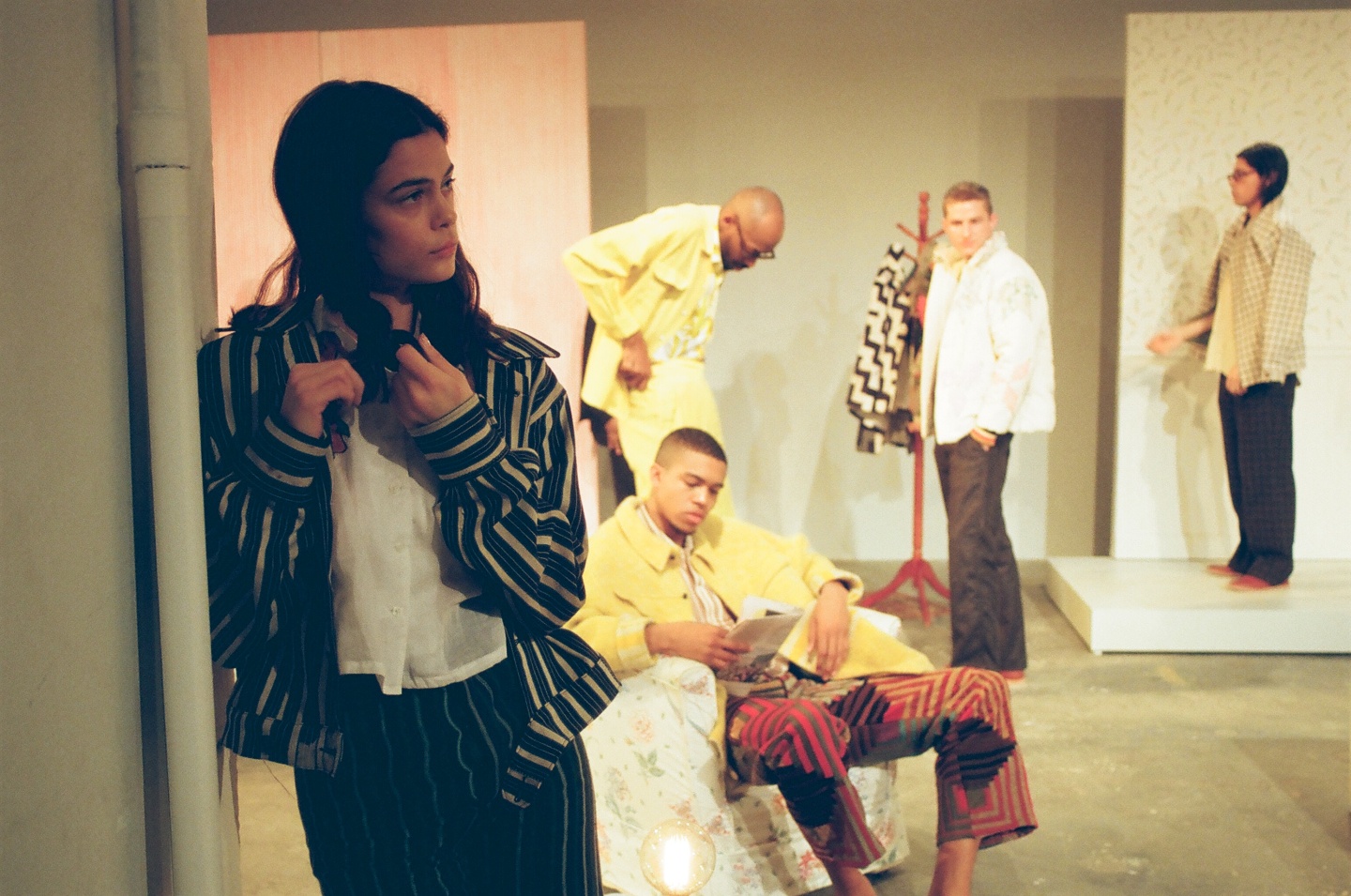 A scene from Bode's debut NYFWM presentation. Photo by Chelsy Mitchell.
A scene from Bode's debut NYFWM presentation. Photo by Chelsy Mitchell.
Emily Adams Bode wanted to recreate the “golden hour.” In her inaugural presentation as part of the CFDA Emerging Designer showcase in early February, the 27-year-old designer behind the menswear line Bode tapped into the “warm glow” of her youth when she journeyed to Cape Cod with family. “It’s a presentation on a memory, but it’s recognizable as a human experience,” she said.
And because the sun’s reach has the capacity to make everything familiar be seen, quite literally, in a new light, her NYFW: Men’s presentation took the form of a deconstructed home, with bedroom, living room, kitchen, and front yard sets split in a stage-like view. Wearing Bode’s one-of-a-kind, quilted and woven cloth pants, shirts, and jackets, models performed day-to-day mundanities like watering plants, reading the paper, or drinking coffee, while others performed slow, deliberate choreographed movements. The presentation was a mesmerizing vision reminiscent of Frank Ocean’s recent visual album ENDLESS — there wasn’t really an apparent purpose, but you focused on each model's movements and actions. It was a subtle way to highlight the clothes, practical yet sentimental items to be worn day in and day out.
The FADER recently spoke with Bode to talk about the line’s stunningly beautiful and confoundingly emotional debut presentation, the whimsical pragmatism captured by each of the collection’s individual pieces, the value in one-of-a-kind items, and why she focused on casting young creatives for her show instead of conventional models.
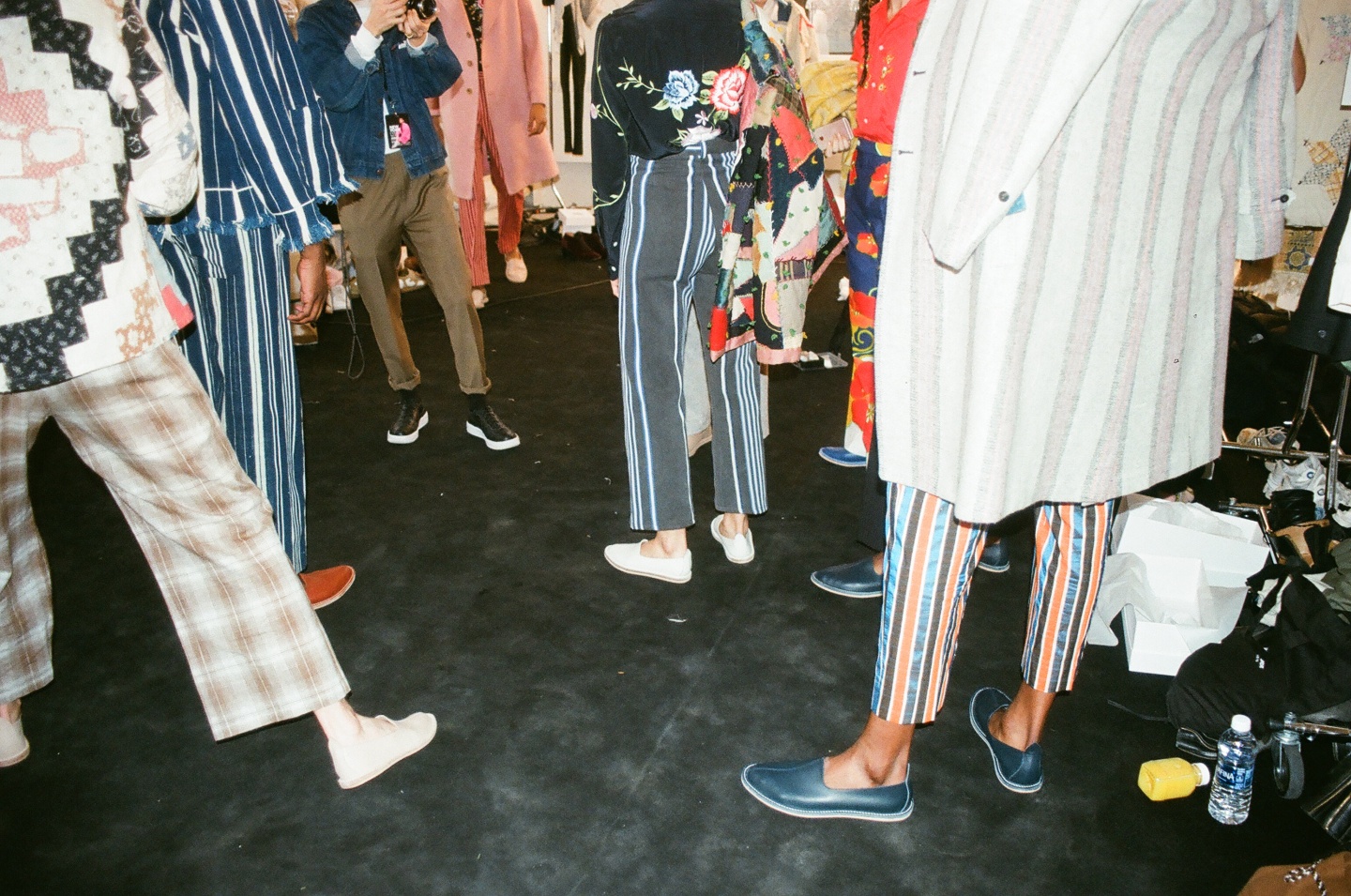 Backstage at Bode's debut NYFWM presentation. Photo by Chelsy Mitchell.
Backstage at Bode's debut NYFWM presentation. Photo by Chelsy Mitchell.
What was your upbringing like? Did you always know you wanted to be in fashion design?
EMILY ADAMS BODE: I was raised in the suburbs of Buckhead [Atlanta]. I was always drawn to fashion, and I have sketches from childhood, dress and fashion drawings, and saved collages of all my favorite looks and models. I never really reflected on it, and then when I was cleaning out my parents’ house, I found binders full of cut-out images of fashion. But it never really resonated as me really [pursuing] it as a kid.
I went to a very creative high school; we took a lot of art classes. I didn’t really realize that you could be a fashion designer until senior year of high school, and maybe when I was at Parsons. I kind of thought that the more practical jobs were being a stylist or in textile manufacturing. I took summer programs at Amherst College for fashion, but I don’t think anything really compared to once I got to Parsons, and actually learned how to sew with an industrial machine.
I graduated about four years ago after finishing a dual degree program — philosophy from Eugene Lang College and Menswear at Parsons — and started doing photography and consulting, helping friends’ brands. I worked retail for a long time and I think that’s where I understood what was missing in the market: people just want interesting things.
So when did you start Bode?
In July, so it’s been seven months.
Did anyone at home or in your family encourage you along the way? Who were your inspirations?
My parents for sure. My dad’s a doctor, he’s not necessarily creative, but he has believed in the brand since I was first talking about it, just because I have always talked about having my own company. My mom is the more creative one; she is a painter and her sisters and her mother were very much into fashion. My mom dressed only in vintage when she was in the 1960s and ‘70s. She saved a lot of her clothes, so a huge portion of my closet is her clothing from college. One of my aunts is a photographer, and she did some feminist art in the ‘70s where she made quilts. That sort of thing didn’t really resonate when I was cutting up quilts, which was so ingrained in me. My doll bed blankets were all pieces of quilts.
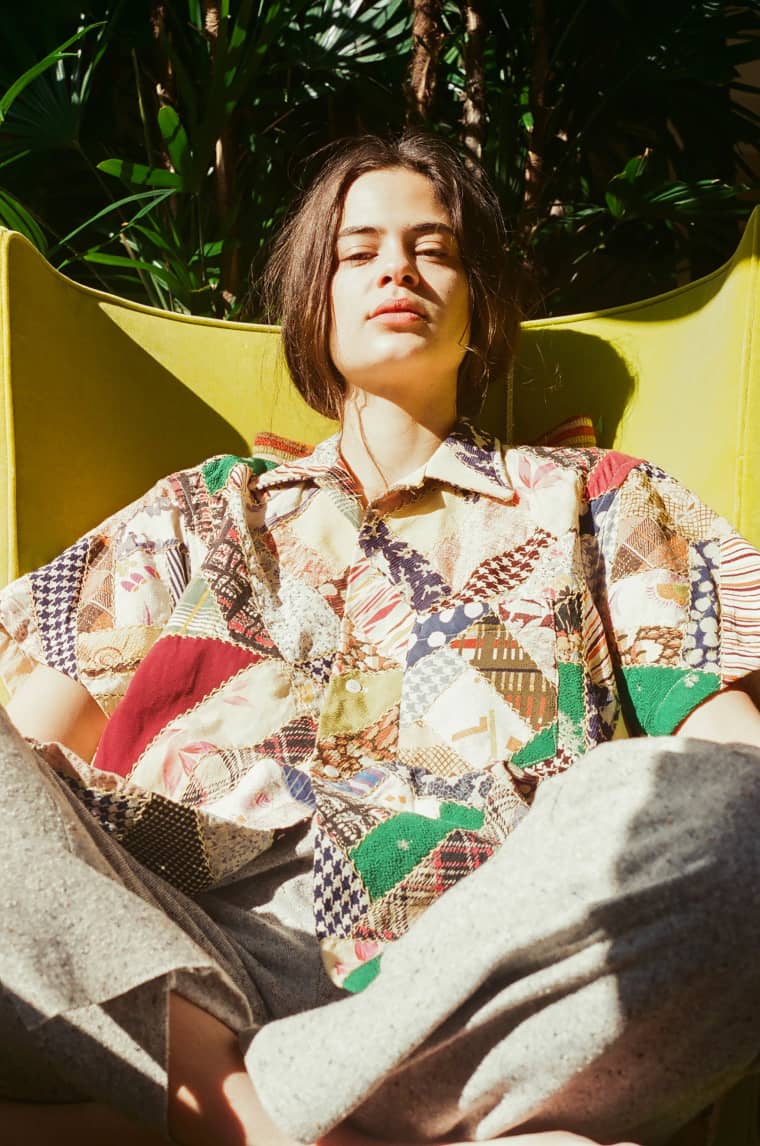 Photo by Tyra Mitchell for The Upsetter
Photo by Tyra Mitchell for The Upsetter
 Photo by Cam Hicks for The Upsetter
Photo by Cam Hicks for The Upsetter
Bode's pieces have a comforting aesthetic — lots of simple silhouettes, quilts, and patterns that feel wearable in real life. What was the thought behind this collection?
I make pretty pragmatic, wearable menswear — despite fabrication, one size fits most. I have started to incorporate more sizes, but for the most part, i’'s just two [sizes]. I had always been very practical about pocket placements. I was inspired by utilitarian clothing, or workwear, French workwear, and military clothing. Even though I’m making pink quilts, or embroidered shirts, it’s guys wearing it.
I like the oversized look; it’s really cute and I like the simplicity of it. If anything, my shapes are comfortable. I’ve had two people say that they’ve slept in their jackets, which is insane. I think it’s so comforting, it’s made out of bedding. It’s funny when people are like, “Oh my gosh, I can’t believe how warm the jacket is.” But really? It’s a quilt! Of course it’s warm! You think about warmth and comfort, especially for winter looks, but blankets are filled with the same things [as winter jackets]. A 1970’s wool blanket is really gonna be just as warm.
I do the mending and I do some embroidery, but all the embroidery you see is from before, it’s antique embroidery that was done on the original piece, before [the fabric] was made into a shirt. I do all the appliqué, which is done after the fact.
The colors are bright: it’s fun, it’s whimsical, but it’s still very much menswear. It’s weird reading people say, “It doesn't look like menswear.” I can see that when I put certain editorial looks together, when I pair a pink overcoat and quilted clothes, that they could be pajamas or something. But the way that people shop — they’re not buying the whole look, they’re buying individual items. I have to put looks together because of the show, or for the lookbook’s sake. But ideally, I sell items individually unless I’ve made a pant and shirt set out of it.
Each piece has a life of its own.
That’s the nature of what I’m making my clothing out of, before I made it into something. You have these women making blankets and quilts as one-off pieces. It wasn’t really supposed to pair with anything, it kind of just goes with everything, like a print. You buy into these pieces because that individual item is lovely to you, or you have so many associations about it, or you really like that specific striped detail, like that coat that’s made from a striped blanket. That’s the way that I like buying objects, and collecting. You’re drawn to this individual item and the brand as a whole.
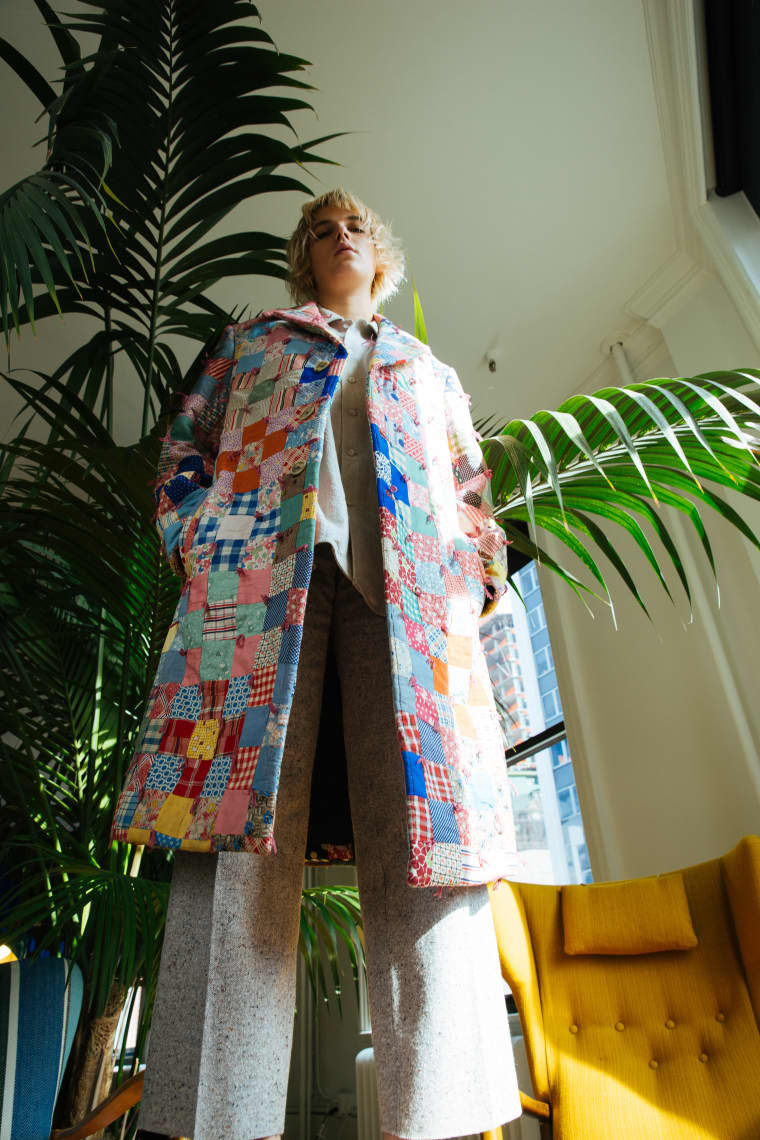 Photo by Cam Hicks for The Upsetter
Photo by Cam Hicks for The Upsetter
 Photo by Cam Hicks for The Upsetter
Photo by Cam Hicks for The Upsetter
Do you think that lends to the idea that more people are creating clothes outside of the designated seasons?
I understand it for buyers because they have to put money aside per season, but otherwise, people struggle in the industry with things like Instagram, or when everything is seen the whole six months before it’s even shipped — that’s been such an issue for brands that they’ve not allowed phones in their showrooms or fashion shows. But that’s not the way that the young generation is moving. They want to see everything immediately. It’s a little tricky.
I don’t have samples; I just make straight into production because everything is one of a kind. You kind of take a risk, but that’s why I try to keep my styles to a minimum. Especially right now, I’m making so few clothes, a couple hundred pieces.
I’ve been so careful about who’s making my clothes and where I’m making them, you know, I make everything in New York and I use specific tailors — that’s such an important part of BODE. I use a tailor here, Martin Greenfield, known for their tailored wear.
I buy a lot of my fabrics in Atlanta because I’ve had relationships with antique dealers and different vendors since I was little, who I still buy from. I have had a lot [material] come from England and France but most everything is coming from Massachusetts, Philadelphia, and Ohio.
Where else do you draw inspiration for your clothing, outside of antiquing and places you already get materials from?
I love looking at old photographs of Herman Hesse. His style is so beautiful, his whole way of life when he lived with his friends in Ticino. The way they dressed in the summertime was very airy and clean: linens, traditional, very beautiful safari style jackets and button ups.
 A scene from Bode's debut NYFWM presentation. Photo by Chelsy Mitchell.
A scene from Bode's debut NYFWM presentation. Photo by Chelsy Mitchell.
Your presentation was so beautiful and emotional — the “home” set design, the choreographed movements, the ambient music. What’s the story behind it all?
The presentation was based off of phone conversations I had with my mom and her aunt about their upbringing — those were probably the most informative of how we were dressing the set and how I was making the kinds of clothes I wanted to focus on. They talked about their Cape house and a tragedy that happened when they were young adults. My mother’s father died when she was my age so they had to say goodbye to their home, something so personal to my mother and her sisters. They kept this tradition of going to the Cape with my sister and I, and it remains one of the most important aspects of our lives, as it was with theirs.
They spoke about how they were raised [there], the sun coming through the windows — its warm glow. I focused on this golden hour — that’s why there are a lot of yellows and oranges in the collection. It’s a presentation on a memory, but it’s recognizable as a human experience.
Norman McLaren’s film Neighbors was also a big inspiration [for the show] — it’s a movement piece, and all of the gestures of Bruno Munari, 1920’s Hans Richter Dada films, and lounging images from Éric Rohmer’s movies.
The music was this transient sound with field recordings of birds. We had a recorded track that [three musicians] made and then they played on top of the track as well. They made this beautiful, atmospheric kind of sound. Some [tracks] were moreso songs and then some were more noise with birds. The recorded sounds actually came from a trip when [one of the instrumentalists] came with me to Cape Cod and recorded the field sounds.
Julia Crockett, the choreographer — she created this slow, little movement, a few steps that people would do on loop. If they weren’t doing the movement, they would be reading the newspaper, tossing it aside, getting endless coffee cups, talking on the phone, maybe folding stuff by the bed. [The movements] would get a little bit more performative when two people would join in with each other.
Not everyone cast in the show was a model, right? Why?
It was all creative young people. It’s funny the way that people respond when you have a regular fashion show — you never reflected on them and said, “Wow that was a beautiful group of people” — it was obvious. People keep commenting on how beautiful the group was and I think it’s because they’re not your typical models, so you look at them in the clothes moreso, and you’re looking at them as real people. It was a nice collaborative way to meet all these young people who are interested in the same things, who are interested in coming together and creating a beautiful project and doing something that was collaborative, which is really important right now — to just be able to discuss with people how you’re feeling and what’s going on. Like, “Why is this emotional?”
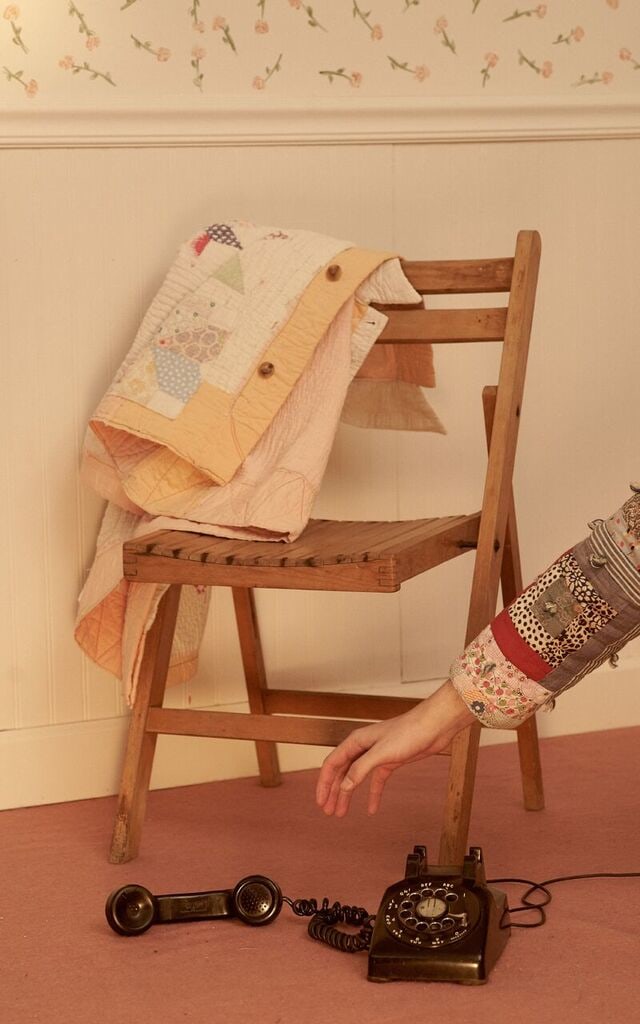 Photo by Phil Patton.
Photo by Phil Patton.